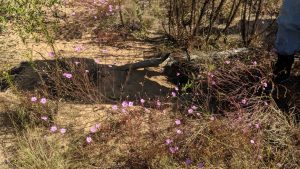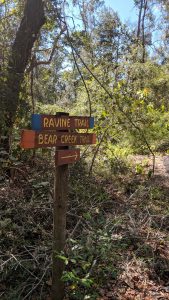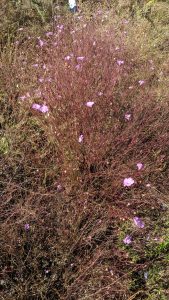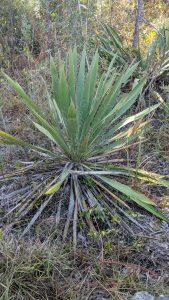I’m a big fan of butterflies and pretty much all pollinating, six-legged creatures. At Bear Creek Educational Forest, I was in for a treat. My Florida Master Naturalist class (UF/IFAS) welcomed bug expert, Billy Boothe to lead us on an insect adventure. It turns out, we can tell a lot about a place based on the bugs we see there.

Today, we ventured along the steep ravines and southern hardwood forests along Bear Creek. Billy used a large, white square net to find bugs, shaking limbs over the net and exclaiming each sighting. From small jumping spiders to bright green katydids, Billy had a passion for each critter and the important roles they play in their ecosystems.
Florida has more than 170 butterfly species, and North Florida is home to 135 of them. Native plants in our conserved areas sustain vulnerable populations, not just as butterfly food sources, but for caterpillars as well. Buckeye caterpillars love false foxgloves, and I saw this in action while purveying Bear Creek. The pink flowers’ leaves are the only food source for Buckeye babies. Relying on only one larval plant species is not uncommon among butterflies. For example, Monarchs love milkweed, Zebra longwings love passion vine, and rattlebox moths love ghost orchid. This pickiness can sometimes be their downfall, especially as large natural landscapes are lost to development.

What we do to insects often finds its way to other wildlife we love. A sad example is on golf courses, where groundskeepers eradicate Northern mole crickets with pesticides. The crickets are the primary food source for burrowing owl, and as they are eaten by the owls, the toxins within the crickets poison the bird.
Pollinators have historically been seen as pests. From stinging bees to Florida’s seasonal lovebugs (they pollinate sumac!), insects serve a crucial purpose in Florida’s agriculture and land conservation efforts. We need them to live. And now, they need us to save their lands.
As we worked day and night to write the Gems Report, I learned about a lot of different bugs. One in particular, the blue calamintha bee, only lives along the ever-dwindling Lake Wales Ridge. This blue bee only eats a specific plant, Ashe’s calamint, and with every encroaching development, more of its habitat is lost. This is certainly not the only rare Florida species that is fighting for its survival.
To protect habitat for the smallest bug to the largest bear, we have to conserve more land and fast.





